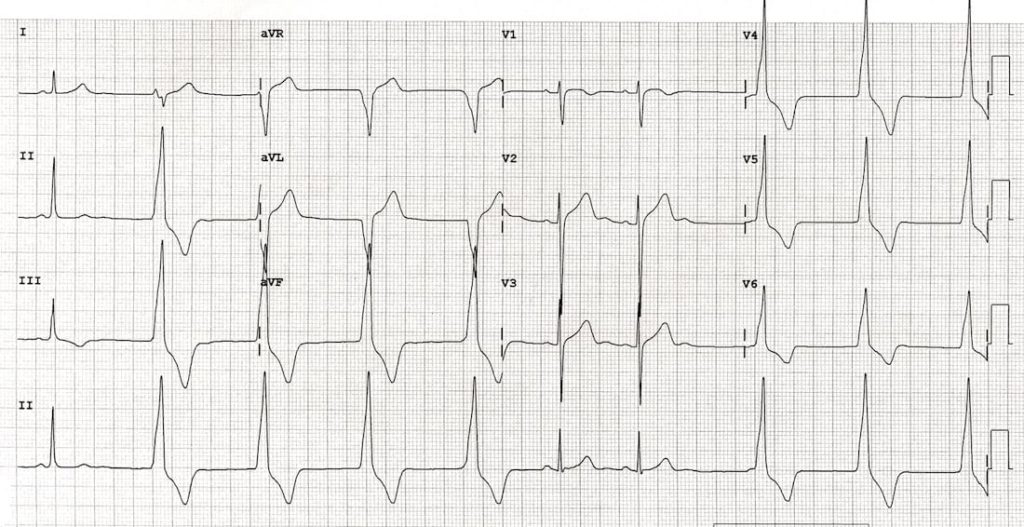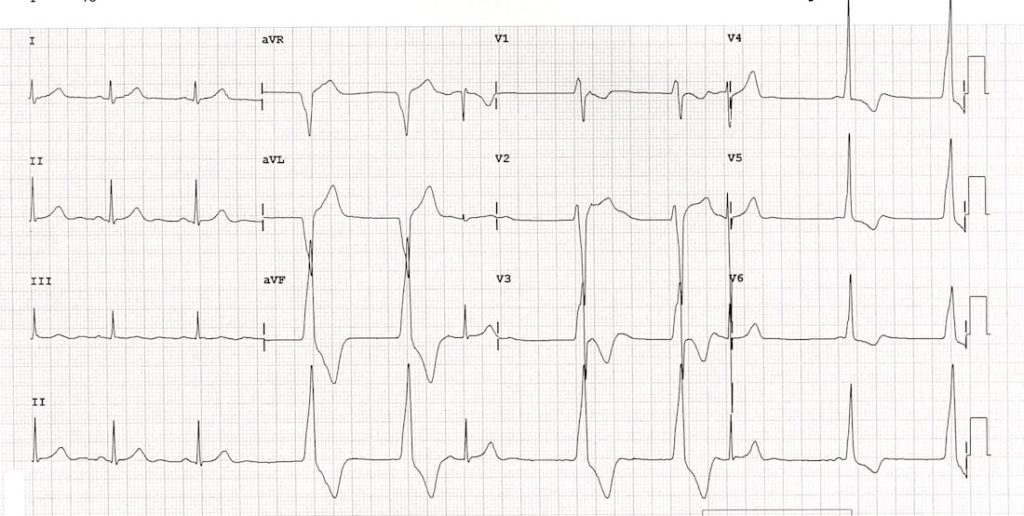ECG Case 040
36-year old old athlete, asymptomatic. Describe the ECG.
ECG 1

ECG 2

Describe and interpret this ECG
ECG ANSWER and INTERPRETATION
Main Abnormalities
There are two competing rhythms at similar rates (= isorhythmic AV dissociation):
- Accelerated idioventricular rhythm (AIVR) — broad-complex ventricular rhythm at around 60 bpm.
- Sinus bradycardia with sinus arrhythmia — the sinus rate varies from 70 bpm down to < 50 bpm.
The QRS morphology varies depending on which focus is capturing the ventricles at any given moment.
Other Findings
Specific ECG findings that confirm the presence of simultaneous sinus and ventricular rhythms are:
- Capture beats — sinus beats that intermittently wrest control of the rhythm producing narrow complexes.
- Fusion beats (seen in the second ECG) — these are intermediate width complexes that occur when sinus and ventricular beats coincide.
NB. Fusion and capture beats are often discussed in the context of VT. They are not specific to VT, but rather can be seen with any ventricular rhythm, including paced rhythms and AIVR.
Explanation
- Competing sinus and ventricular pacemakers are present. There is underlying sinus arrhythmia, with sinus capture occurring when the sinus rate exceeds the idioventricular rate.
- This patient was a fit athlete with presumably high resting vagal tone that suppressed his sinus node output and allowed an ectopic ventricular pacemaker to emerge.
CLINICAL PEARLS
Definitions
Accelerated idioventricular rhythm
An ectopic ventricular rhythm consisting of three or more ventricular complexes occurring at a rate of 50-110 bpm. The rate differentiates AIVR from ventricular escape rhythms (rate < 50 bpm) and VT (> 110bpm).
Isorhythmic AV dissociation
AV dissociation with sinus and ventricular complexes occurring at similar rates, unlike 3rddegree heart block where the atrial rate is usually faster than the ventricular rate. Isorhythmic AV dissociation is usually due to functional block at the AV node from retrogradely conducted ventricular impulses (“interference-dissociation”), which leaves the AV node refractory to the anterograde sinus impulses.
References
Further Reading
- Wiesbauer F, Kühn P. ECG Mastery: Yellow Belt online course. Understand ECG basics. Medmastery
- Wiesbauer F, Kühn P. ECG Mastery: Blue Belt online course: Become an ECG expert. Medmastery
- Kühn P, Houghton A. ECG Mastery: Black Belt Workshop. Advanced ECG interpretation. Medmastery
- Rawshani A. Clinical ECG Interpretation ECG Waves
- Smith SW. Dr Smith’s ECG blog.
- Wiesbauer F. Little Black Book of ECG Secrets. Medmastery PDF
TOP 100 ECG Series
Emergency Physician in Prehospital and Retrieval Medicine in Sydney, Australia. He has a passion for ECG interpretation and medical education | ECG Library |
